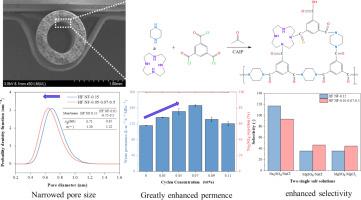High performance composite hollow fiber nanofiltration membrane fabricated via the synergistic effect of co-solvent assisted interfacial polymerization and macrocyclic polyamine incorporation
IF 8.3
1区 工程技术
Q1 ENGINEERING, CHEMICAL
引用次数: 0
Abstract
The necessity for high-performance thin film composite (TFC) nanofiltration (NF) membranes for drinking water and wastewater treatment is becoming increasingly apparent in the face of the global water crisis. In this work, co-solvent (acetone) assisted interfacial polymerization (CAIP) and incorporating macrocyclic polyamine (Cyclen) as an aqueous co-monomer were employed to fabricate hollow fiber (HF) NF membrane and to enhance the permeability and the selectivity, respectively, thereby overcoming the inherent trade-off effect. The effects of Cyclen and acetone on the separation performance were comprehensively investigated, and the interfacial polymerization conditions were optimized. The optimal HF NF membrane exhibits a 68.6 % increment in water permeance relative to the baseline membrane while without sacrificing the Na2SO4 rejection which is as high as 99.2 %. In particular, it exhibits a superior high pure water permeability of 222.5 L m−2 h−1 MPa−1, ranking among the highest observed for HF NF membranes in the existing literature. Moreover, it exhibits excellent acid resistance as well as fouling resistance. This research paves a novel approach for developing high-performance HF NF membranes for water and wastewater treatment.

通过共溶剂辅助界面聚合和加入大环多胺的协同效应制造高性能复合中空纤维纳滤膜
面对全球水危机,将高性能薄膜复合(TFC)纳滤(NF)膜用于饮用水和废水处理的必要性日益明显。本研究采用共溶剂(丙酮)辅助界面聚合(CAIP)技术,并加入大环多胺(Cyclen)作为水性共聚单体,制备了中空纤维(HF)纳滤膜,并分别提高了渗透性和选择性,从而克服了固有的权衡效应。全面研究了环烯和丙酮对分离性能的影响,并优化了界面聚合条件。与基线膜相比,最佳 HF NF 膜的透水率提高了 68.6%,同时不影响高达 99.2% 的 Na2SO4 阻隔率。特别是,它的纯水渗透率高达 222.5 L m-2 h-1 MPa-1,是现有文献中观察到的 HF NF 膜中最高的。此外,它还表现出优异的耐酸性和抗结垢性。这项研究为开发用于水和废水处理的高性能高频无负压膜铺平了一条新路。
本文章由计算机程序翻译,如有差异,请以英文原文为准。
求助全文
约1分钟内获得全文
求助全文
来源期刊

Desalination
工程技术-工程:化工
CiteScore
14.60
自引率
20.20%
发文量
619
审稿时长
41 days
期刊介绍:
Desalination is a scholarly journal that focuses on the field of desalination materials, processes, and associated technologies. It encompasses a wide range of disciplines and aims to publish exceptional papers in this area.
The journal invites submissions that explicitly revolve around water desalting and its applications to various sources such as seawater, groundwater, and wastewater. It particularly encourages research on diverse desalination methods including thermal, membrane, sorption, and hybrid processes.
By providing a platform for innovative studies, Desalination aims to advance the understanding and development of desalination technologies, promoting sustainable solutions for water scarcity challenges.
 求助内容:
求助内容: 应助结果提醒方式:
应助结果提醒方式:


